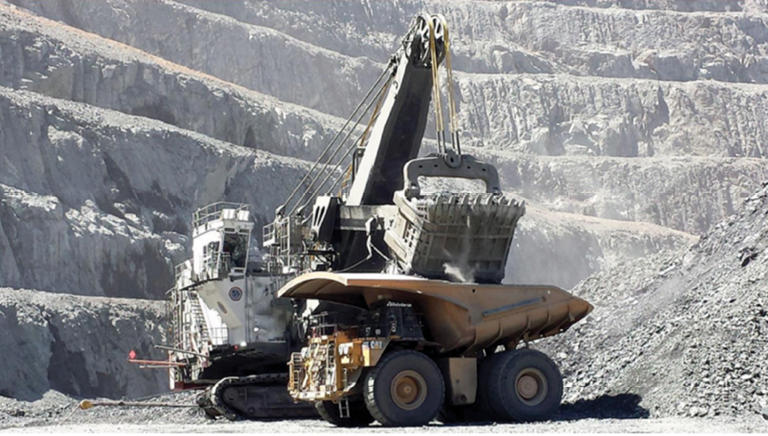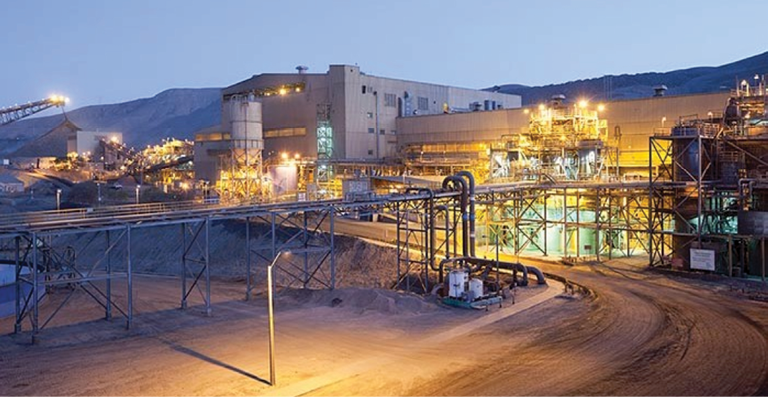The Candelaria copper operation is in the early stages of a multifaceted project to extend mine life to 2030
By Oscar Martinez Bruna, Latin American Editor

The mine’s production fleet includes 46 haul trucks, seven shovels and eight production drills. (All photos: Lundin Mining Corp.)
Lundin Mining Corp., the 80% owner and operator of the Candelaria copper mine in northern Chile, is laying the groundwork for a $460 million plan to extend the life of the mine to 2030, which, in addition to the operational advantages afforded by pit expansion and a new, high-capacity tailings storage facility, would allow it to continue to support the thousands of direct and indirect jobs generated by Candelaria’s operations, its commerce with local and national suppliers of services and consumables, and to maintain a social investment policy encouraging sustainable development and quality-of-life improvements for nearby communities.
Minera Candelaria is located at Tierra Amarilla, 25 km south of the city of Copiapó in Chile’s Atacama region. The mining operation encompasses the Candelaria open pit and the Candelaria Norte, Santos and Alcaparrosa underground mines. The district offers a favorable mining environment that includes nearby urban centers and relatively low altitude, along with a large desalination plant that supplies the mine’s water requirements, and a captive port for shipping copper concentrate.
Lundin Mining is a Canadian company producing copper, zinc, lead and nickel, with operations and projects in Chile, Portugal, Sweden, Spain, the United States, Finland and the Democratic Republic of Congo. Its corporate offices are in Toronto, Ontario, and its operational head office is located in the U.K. It acquired an 80% interest in the Candelaria operations from Freeport McMoRan Inc. in November 2014. Sumitomo Corp. owns the remaining 20% share in the mine.
Since startup in 1994, the mine has produced more than 3.6 million metric tons (mt) of copper, along with gold and silver as byproducts.
Surface and Underground Mines
The open pit operates at a rate of 270,000 mt/d, feeding 66,000 mt of ore to a 75,000-mt/d concentrator. The Candelaria Norte underground mine extracts another 6,000 mt/d, while Alcaparrosa and Santos, the two underground mines at the older Ojos del Salada operation to the north contribute 4,000 mt/d and 3,800 mt/d, respectively.
All three underground mines use sublevel open stoping. Current mine lives for Candelaria Norte, Alcaparrosa and Santos are 13, 7 and 7 years, respectively. Life of mine ore grade for Candelaria Norte is 0.96% Cu; Alcaparrosa, 0.94%; and Santos, 1.04%. Lundin plans to increase the production rate at Candelaria Norte from 6,000 to 6,500 mt/d in 2016; and again in 2018–2019 to 7,250 mt/d.
Ore from the pit is mined from an iron oxide copper-gold deposit with high chalcopyrite content, associated with magnetite. It is being extracted in several phases, and as of June 2015, five phases remain over the course of the pit’s current 17-year life of mine. The reported stripping ratio is 2.81. Mill grade for copper is 0.52%; gold, 0.12 g/mt; and silver, 1.88 g/mt. The final concentrate contains 30.2% Cu.

The 75,000-mt/d concentrator is fed from a 450,000-ton-capacity crushed-ore stockpile.
The mine’s current production fleet includes 46 high-capacity haul trucks, seven shovels and eight production drills. Ore reduced by the mine’s 60 x 89-in., 700-hp Fuller-Traylor gyratory crusher is conveyed to a 450,000-mt-capacity stockpile for processing. Further reduction is handled by Metso HP 700 and MP 800 cone crushers, producing material sized at >85% –1/2 in.
The Candelaria concentrator began production in 1995, while the Pedro Aguirre Cerda (PAC) plant, which processes ore from the Ojos del Salada Santos mine, has been in operation since 1929. The older plant’s current throughput rate is 3,800 mt/d, and it is expected to operate at that capacity at least until 2021. Ore from the Alcaparrosa mine is treated at Candelaria.
The Candelaria processing plant flowsheet is conventional, comprising two parallel process lines for grinding and flotation, reclaimed process water from a tailings dam, final concentrate filtration, and shipping of bulk copper concentrates. Grinding takes place in a closed circuit using semi-autogenous grinding (SAG) mills, ball mills, and pebble crushing. A multistage flotation circuit, comprising 24 rougher cells, 12 scavenger cells and 10 column cells produces copper concentrate with gold and silver byproduct metals. Final flotation tails are thickened and delivered to a rockfill embankment tailings storage facility. Process water is reclaimed from the tailings dam for reuse in the processing plant.
The concentrate produced by flotation is filtered through a process that reduces moisture content from 66% to 9%. Candelaria’s filter plant has two filtration lines containing four ceramic filters for each phase. The concentrate is stored and shipped via truck to the port of Punta Padrones in Caldera and also to other local buyers.
Tailings from the Candelaria plant are treated under contract with Compania Minera del Pacifico S.A. (CMP) to produce a magnetite concentrate, which is sent via pipeline to CMP’s port near Caldera. Non-magnetic material is deposited in Candelaria’s TSF.

Final concentrate is filtered, stored and shipped to the port of Punta Padrones for delivery to European and Asian customers. Magnetite in plant tailings is recovered by a third party and transported by pipeline to the coast.
Copper From Caldera
The port of Punta Padrones is located at Caldera Bay, 110 km from the mining operations. It has a nominal storage capacity of 45,000 wmt and is designed for minimal environmental impact, with three main buildings operating at negative pressure to prevent dust emissions during concentrate handling. Similarly, all facility conveyor belts are enclosed to prevent fugitive dust emission during transfer.
Punta Padrones has an annual capacity of about 3.5 million wmt/y, but its utilization rate is quite low—the company projects maximum annual concentrate production over the remaining LOM at about 600,000 wmt/y—leaving room for potential sharing and cost savings by attracting other concentrate exporters and/or bulk commodity importers. It can load ships at a rate of 1,000 wmt/h; typically, three vessels are loaded per month. Copper concentrate produced in the Candelaria district is shipped mainly to European and Asian markets.
The desalination plant, commissioned in 2013 and located at the port site, has allowed the company to eliminate any need to draw fresh water from the Copiapó River basin. Processing capacity at the conventional reverse osmosis plant is 500 L/sec of industrial-quality desalinated water, which is delivered to the mine via a 110-km-long pipeline and booster pump station. According to Lundin, its long-term plans to extend mine life at Candelaria will require increased utilization of the desalination plant.
Longer Life Ahead
Those long-term plans are part of the Candelaria 2030, Operational Continuity project intended to allow the company to extend the mine’s life to 2030. The project includes pit enlargement to explore new reserves, an increase of 610 and 140 million additional mt, respectively, to the current storage capacity for the Norte and Nantoco waste rock dumps, and construction of a new tailings dam, Los Diques, with capacity for 600 million mt, covering an approximate surface area of 690 hectares. In addition, it will require relocation of some power transmission lines and some sections of highway C-397 that are necessary for the continuity of the operations.
The project, which is expected to begin full ramp-up in 2018, is currently in the early-works phase, involving relocation of power lines and work site installation. According to Lundin, these activities have required the outsourcing of certain services and the company has given priority to local providers, along with hiring local workers as needed; it is expected that local hiring will increase as the project progresses.
A Sustainable Future
Mine management told E&MJ that its vision of Minera Candelaria is to be a highly profitable company that is appreciated by the community for its ongoing efforts to build a sustainable future for the Atacama region. With this aim in mind, over the last few years, the company has been developing a program called Construyamos el Futuro (Let’s Build the Future), aimed at identifying opportunities to upgrade productivity levels, reduce operational costs and encourage innovation. The goal, mine managers explained, is to “see that every department in the company is able to spot opportunities and implement actions targeted to achieve continuous improvement, thus giving sustainability to the entire operation.”




